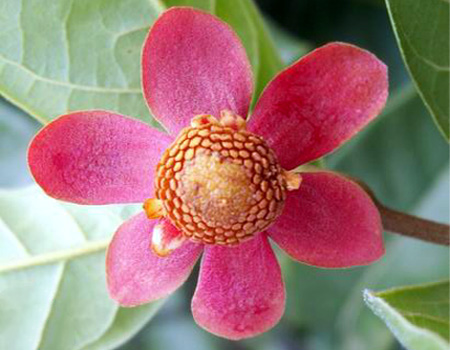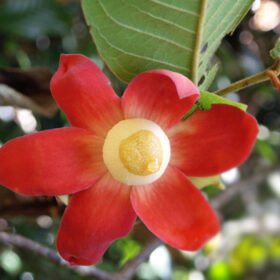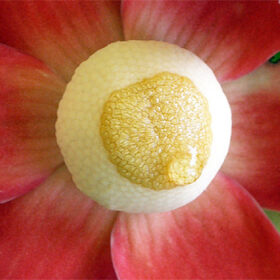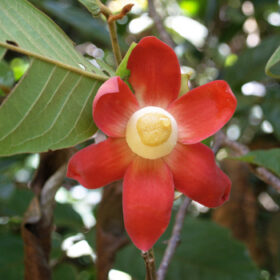Diagnostic Characteristics:
Woody vine, 8-10 m long. Young branches with yellowish-brown downy hairs. Leaves obovate, (11)13-19(24) x (3)5-7(10) cm, apex with a short tip, base rounded or slightly cordate; upper surface glabrous, lower surface densely hairy; lateral veins approximately 13-20 pairs, prominent on the underside; petiole 4-5 mm long. Flowers usually solitary; pedicel 1-2 cm long, with 2 large bracts (2.5-3.5 x 2-3 cm), bracts leaf-like. Sepals enclosing the bud, long and thin, ovate or rounded, 2 cm in diameter, with short hairs on the outer surface.
Petals free, purplish-red, ovate, 3-4 x 2 cm, hairy on both surfaces. Stamens 6-7 mm long, sometimes with hairs on the edges of the anther; connective appendage tongue-shaped, very small. Ovules 20-30. Receptacle convex, hemispherical, sometimes slightly concave at the apex. Fruitlets cylindrical, 4-6 cm long, 1-1.5 cm wide, with yellowish-brown downy hairs; fruitlet stalk 1-2 cm long; pericarp thick (up to 1-2 mm). Seeds yellowish-brown, smooth.
Biology and Ecology:
Flowering occurs from April to June, fruiting from August to September. Found scattered in primary and secondary forests, at altitudes below 300 m.
Distribution:
Thanh Hoa, Quang Binh (Bo Trach, Ba Ren), Quang Tri, Thua Thien – Hue (Phu Loc, Song Hai Nhanh), Da Nang (Tourane), Quang Nam (Cu Lao Cham), Khanh Hoa (Hon Tre), Dong Nai (Bien Hoa). Also found in India (Calcutta), Myanmar, China (Guangxi, Hong Kong, Hainan), Sri Lanka, Malaysia, Indonesia (Java).
Notes:
Some authors, such as Sinclair (1955:202) and Y. Tsiang & P. T. Li (1979:26), who considered Uvaria grandiflora as the official name of this taxon, have cited the original document incorrectly. According to Sinclair, and Y. Tsiang & P. T. Li, the name Uvaria grandiflora was published in 1824 in the “Flora Indica” on page 665.
In reality, the “Flora Indica” (1824) only has 558 pages, and the name is not mentioned; it was only mentioned in the 2nd edition of “Flora Indica,” released in 1832 and on page 665. Many other authors, including Backer & Bakhuizen f. (1965), still consider Uvaria purpurea as the official name of this taxon.




